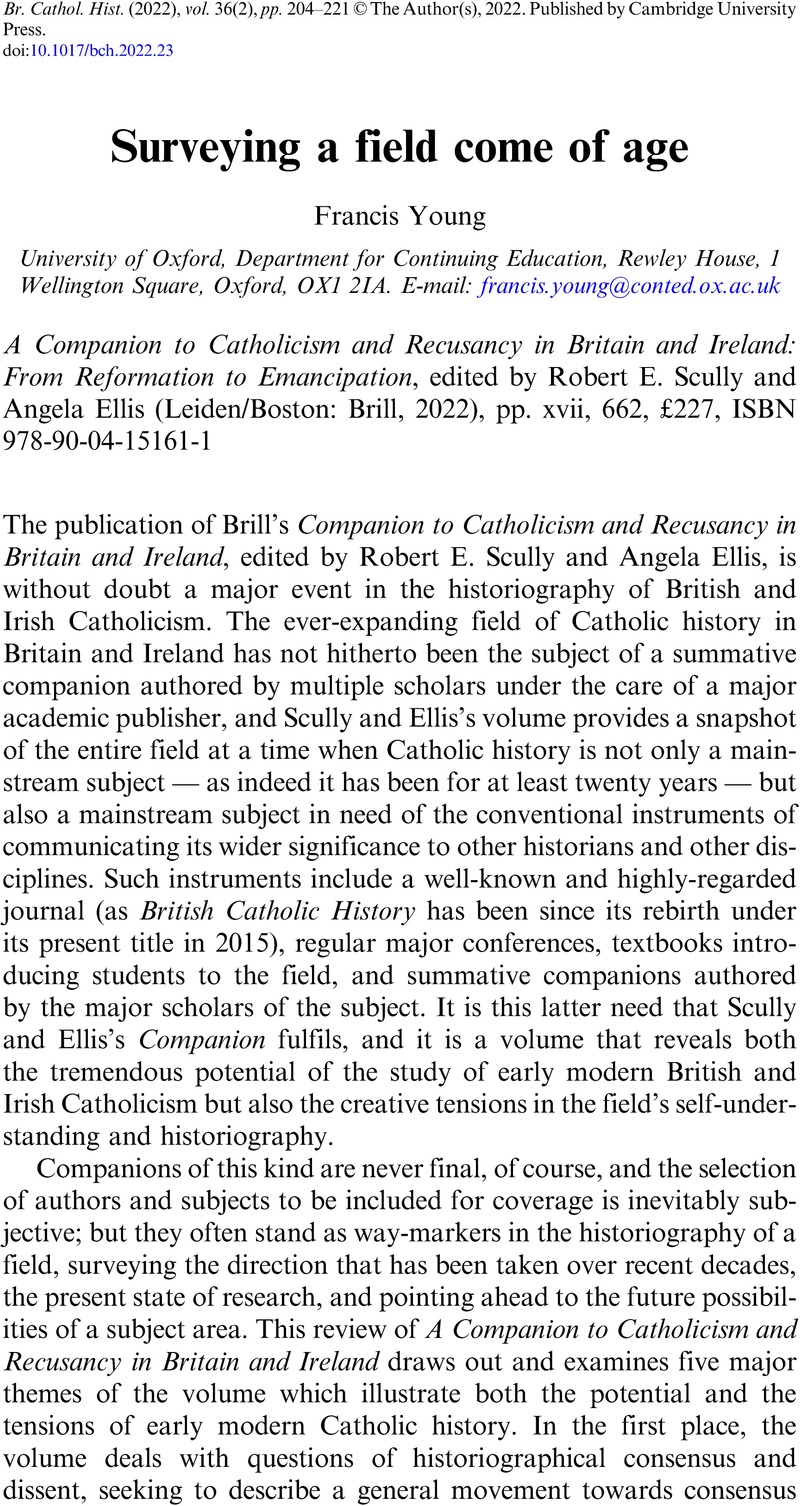No CrossRef data available.
Published online by Cambridge University Press: 07 November 2022

1 See Christopher Haigh, Reformation and Resistance in Tudor Lancashire (Cambridge: Cambridge University Press, 1975); Christopher Haigh, The English Reformation Revised (Cambridge: Cambridge University Press, 1987).
2 Alexandra Walsham, Church Papists: Catholicism, Conformity and Confessional Polemic in Early Modern England (Cambridge: Boydell, 1999).
3 See, for example, Michael Questier, Conversion, Politics and Religion in England, 1580–1625 (Cambridge: Cambridge University Press, 1996); Michael Questier, Catholicism and Community in Early Modern England: Politics, Aristocratic Patronage and Religion, c. 1550–1640 (Cambridge: Cambridge University Press, 2006); Peter Lake and Michael Questier, All Hail to the Archpriest: Confessional Conflict, Toleration, and the Politics of Publicity in Post-Reformation England (Oxford: Oxford University Press, 2019).
4 John Bossy, The English Catholic Community 1570–1850 (London: Darton, Longman and Todd, 1975).
5 Eamon Duffy, Fires of Faith: Catholic England under Mary Tudor (New Haven, CT: Yale University Press, 2009).
6 Frederick Smith, ‘The Origins of Recusancy in Elizabethan England Reconsidered’, The Historical Journal 60:2 (2017): 301–32.
7 Ceri Law, Contested Reformations in the University of Cambridge, 1535–1584 (Woodbridge: Boydell and Brewer, 2018).
8 Katy Gibbons, English Catholic Exiles in Late Sixteenth-Century Paris (Woodbridge: Boydell and Brewer, 2011); Liesbeth Corens, Confessional Mobility and English Catholics in Counter-Reformation Europe (Oxford: Oxford University Press, 2019).
9 Gabriel Glickman, The English Catholic Community, 1688–1745: Politics, Culture and Ideology (Woodbridge: Boydell Press, 2009); James Kelly, English Convents in Catholic Europe, c. 1600–1800 (Cambridge: Cambridge University Press, 2020).
10 R. Po-chia Hsia, The World of Catholic Renewal, 1540–1770 (Cambridge: Cambridge University Press, 2005); Ulrich Lehner, The Catholic Enlightenment: The Forgotten History of a Global Movement (Oxford: Oxford University Press, 2016).
11 See, for example, James Kelly and Hannah Thomas, eds. Jesuit Intellectual and Physical Exchange between England and Mainland Europe, c. 1580–1789: ‘The World is our House’ (Leiden: Brill, 2018); Teresa Bela, Clarinda Calma and Jolanta Rzegocka, eds. Publishing Subversive Texts in Elizabethan England and the Polish-Lithuanian Commonwealth (Leiden: Brill, 2018).
12 Richard P. Williams, ed. Mannock Strickland (1683 – 1744): Agent to English Convents in Flanders: Letters and Accounts from Exile (Woodbridge: Catholic Record Society, 2016); Philip Perry, Essay on the Life and Manners of Robert Grosseteste, ed. Jack Cunningham (Woodbridge: Catholic Record Society, 2022).
13 Victoria Moul, A Literary History of Latin and English Poetry: Bilingual Verse Culture in Early Modern England (Cambridge: Cambridge University Press, 2022).
14 Emilie Murphy, ‘Adoramus te Christe: Music and Post-Reformation English Catholic Domestic Piety’, Studies in Church History 50 (2014): 240–53; Emilie Murphy, ‘Music and Catholic Culture in Post-Reformation Lancashire: Piety, Protest and Conversion’, British Catholic History 32:4 (2015): 492–525.